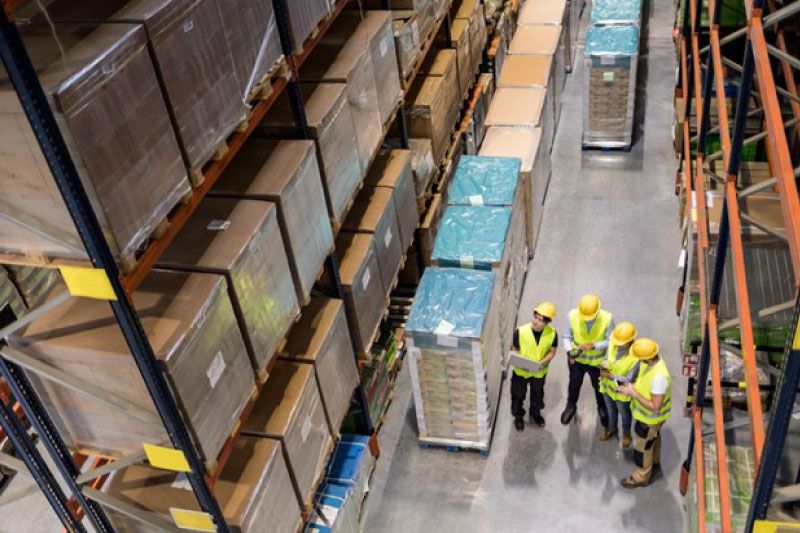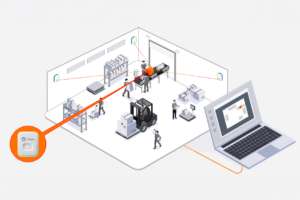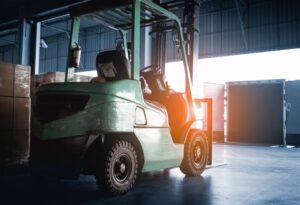In today’s fast-paced warehousing industry, the safe and efficient operation of forklifts is vital. Powered industrial trucks, often referred to as forklifts, play a crucial role in moving heavy loads and keeping the supply chain running smoothly. However, their operation can also be hazardous if not managed carefully. Real-Time Location Systems (RTLS) offer an innovative solution to enhance forklift safety, enabling warehouse managers to improve productivity while safeguarding the well-being of their employees.
In this comprehensive guide, we will delve into the benefits and nuances of implementing RTLS to bolster forklift safety in warehouses.
Table of Contents
Warehouse Safety
Regarding warehouse safety, addressing the risks associated with forklift operations is key. Real-Time Location Systems (RTLS) provide continuous visibility of forklift and pedestrian movements, identifying potential collision points in real time. With visual, audio, or vibration alerts, RTLS helps keep workers aware of nearby hazards, significantly reducing the risk of accidents. Additionally, geofencing capabilities allow for speed control, restricted zone management, and better traffic flow across the facility. By leveraging data-driven insights, warehouse managers can respond to incidents more effectively and implement proactive safety improvements, creating a safer, more efficient work environment.
The Importance of Forklift Safety
Each year, forklift accidents impact a significant number of workers. This concern is magnified by the fact that, over the past decade, there has been an alarming increase of nearly 30% in forklift-related fatalities. When coupled with notable annual forklift-related injury figures from OSHA, it’s evident that there’s a pressing need to strengthen workplace safety measures.
Forklift trucks are crucial in many workplaces, especially in navigating tight spaces. However, without the proper knowledge and training on how to operate a forklift safety, the risks are significant. Mishandling a forklift can lead to collisions with high shelves, potentially causing serious harm to the driver and nearby workers. Moreover, falling loads can result in severe damage, leading to costly replacements.
To ensure the utmost safety in the workplace and protect assets and employees, businesses must implement effective workplace and forklift safety measures. Utilizing technologies like RTLS can greatly reduce the risk of accidents by providing operational visibility.
How RTLS Enhances Forklift Safety
RTLS plays a crucial role in enhancing forklift safety in warehouses and industrial settings. Here’s how:
Real-time Visibility
RTLS provides warehouse managers with a comprehensive overview of their forklift fleet in real time. With an intuitive dashboard, they can monitor the exact location and movements of each forklift. This visibility is particularly valuable in large and busy warehouses, where multiple forklifts and pedestrians are constantly in motion.
Having real-time visibility enables proactive decision-making. Managers can identify potential collision points or congestion areas, allowing them to redistribute tasks or reroute forklifts to optimize efficiency and safety. Moreover, it helps to detect unauthorized use of forklifts or identify any operational inefficiencies that might be affecting the forklift safety of the operation.
Collision Warning
One of the most significant safety advantages of RTLS is its integration with collision warning systems. These systems utilize real-time tracking data to detect potential risks between forklifts and other vehicles, pedestrians, or stationary objects within the warehouse.
When the collision warning system detects a potential risk, it issues warnings to both the forklift operator and the person at risk. These warnings can take the form of visual alerts, audible alarms, or vibrating feedback on the operator’s handheld device. With real-time alerts, operating a forklift safety becomes more manageable, as operators are informed promptly of potential risks, allowing them to act quickly and reduce the probability of accidents and injuries.
Geofencing and Speed Limit Enforcement
Geofencing, facilitated by RTLS, entails setting virtual perimeters or delineated zones within the warehouse. Alerts are activated when a forklift enters or exits a stipulated zone.
This feature excels in demarcating no-entry zones or restricted access areas, such as zones reserved for pedestrians or hazardous material repositories. Should a forklift venture into these areas, the system can autonomously decelerate it or halt it in its tracks until it exits the restricted area. This deters unauthorized access and minimizes the likelihood of accidents involving pedestrians or hazardous materials.
RTLS also paves the way for speed limit regulation. By specifying permissible speeds in designated warehouse areas, the system can monitor and restrict forklift velocities, discouraging reckless driving and thereby diminishing the odds of mishaps.
Operator Training and Behavior Oversight
The data harvested by RTLS can shed light on forklift operator conduct and efficiency. Dissecting this data, warehouse managers can identify recurrent unsafe driving habits, which can then be rectified through targeted training.
Should certain operators persistently flout speed restrictions or exhibit erratic behavior, this data serves as a basis for personalized training interventions. Managers can collaborate with these operators, honing their skills with an emphasis on adherence to safety regulations.
Emergency Response and Incident Analysis
In the unfortunate event of a forklift mishap, RTLS can play a crucial role in incident investigation and post-accident analysis. The system archives historical data detailing the forklift’s speed, location, and movements leading up to the incident.
This archival data equips warehouse managers and safety officials to recreate the incident, pinpointing its root cause. This elucidation can be instrumental in forestalling analogous events in the future by ushering in tailored safety enhancements and procedural refinements.
Strategies for Introducing RTLS in a Warehouse Setting
Incorporating RTLS within a warehouse demands meticulous planning. Here are some strategic pointers to facilitate a seamless integration:
Conduct a Safety Audit
Prior to RTLS adoption, undertake an exhaustive safety evaluation of your warehouse. Highlight zones of elevated risk, discern prevalent traffic patterns and spot potential collision hubs. Grasping these specific safety hurdles allows you to customize the RTLS framework to cater to your warehouse’s distinctive challenges.
Set Clear Objectives
It’s crucial to chart out clear-cut goals for RTLS integration. Ascertain the safety augmentations you aim to realize and designate tangible metrics to gauge your progress. Be it a reduction in collisions, curtailing reaction times to safety notifications, or fostering a robust safety ethos, lucid objectives will channel the integration in the right direction.
Opt for the Right RTLS Solution
Elect an RTLS solution that resonates with your warehouse prerequisites and financial capacity. Factors like precision, reach, scalability, battery longevity, and integration prowess should be factored in. Opt for a configuration that seamlessly meshes with the warehouse’s spatial layout and functional demands.
Chart the RTLS Infrastructure
Plan the RTLS hardware deployment judiciously. This entails the strategic placement of tags, beacons, and sensors at pivotal points within the warehouse. Guarantee comprehensive coverage for all vital sectors and demarcate the perimeters for geofencing.
Integrate with Pre-existing Systems
Ensure your chosen RTLS can meld effortlessly with your extant warehouse management and safety frameworks. Such synergy enables data amalgamation, simplifying operations and ensuring that safety alerts and workflows are managed effectively.
Run Pilot Tests and Forklift Training
Initiate a pilot trial in a confined warehouse segment to assess the efficacy of the RTLS setup. Such preliminary testing brings any lurking issues to the fore, allowing for fine-tuning before a full-fledged rollout. Concurrently, impart thorough training to forklift operators and the broader warehouse team on the optimal use of the RTLS apparatus.
Engage Your Employees in the Process
Actively involve your team during the implementation process. Seek feedback from forklift operators and warehouse staff to understand their concerns and insights. Effective communication about the purpose and benefits of RTLS will encourage acceptance and cooperation during the implementation.
Roll Out Gradually and Monitor Relentlessly
Roll out the RTLS in stages, progressively enhancing its reach and features throughout the warehouse. This strategy not only facilitates easier troubleshooting but also prevents staff from feeling overwhelmed by abrupt changes. Consistently monitor the system’s performance, gathering data to evaluate its effect on forklift safety.
Harness Data for Safety Enhancements
Consistently analyze the data produced by the RTLS system to discern patterns or trends pointing to unsafe behaviors or potential hazards. Harness this data to fine-tune safety protocols, revise training programs, and make informed decisions that enhance warehouse safety.
Commit to Ongoing Improvement
The implementation of RTLS is not a solitary event, but a continuous endeavor. Keep soliciting feedback from employees and stakeholders to amplify the system’s efficacy. Remain informed about the latest in RTLS technology and best practices, adapting your strategy as needed over time.

Tips for Training Employees on Operating Forklifts Safely With RTLS
Ensuring employees know how to operate forklift safety with RTLS is critical. This not only equips them to utilize the technology but also strengthens adherence to safety protocols. Here are tips to guide a successful training session for forklift operators:
- Introduce RTLS Fundamentals: Begin with an overview of RTLS — its workings, advantages, and its pivotal role in enhancing forklift safety. Highlight its function as a tool to enhance both safety and efficiency.
- Engage in Hands-on Training: Facilitate direct interaction with RTLS equipment. Allow operators to familiarize themselves with features like the dashboard, alerts, and collision warning mechanisms.
- Break Down RTLS Components: Detail the various elements of the RTLS system — tags, beacons, sensors — and their placements within the warehouse. Illustrate how these components are integrated into their forklift safety and the warehouse structure.
- Stress on Safety Protocols: Underscore the imperative of adhering to forklift safety standards. Discuss protocols like speed limitations, navigating geofenced zones, and collision alert responses. Remind them that while RTLS aids forklift safety, personal caution is paramount.
- Utilize Real-life Scenarios: Illustrate the efficacy of RTLS using real-world situations. Demonstrate how it aids in collision warning, navigation in busy areas, and speed regulation.
- Outline Emergency Procedures: Equip operators with the know-how to tackle emergencies or accidents, ensuring they’re adept at heeding system alerts and reporting mishaps.
- Revisit Safe Driving Techniques: Cover essential forklift operation techniques — steering control, load management, combined controls, visibility, overhead clearance, parking brake utilization, and safe distancing from pedestrians and other vehicles.
- Promote Data Analysis and Feedback: Enlighten operators about RTLS data analysis to refine their driving. Motivate self-assessment and rectification of identified risky behaviors.
- Schedule Regular Refreshers: Host periodic training to update operators on evolving RTLS functionalities and to reiterate safety norms. Such sessions maintain skill levels and amplify system appreciation.
- Encourage Questions and Feedback: Cultivate a setting where operators can freely ask questions and offer feedback. Address concerns and remain open to enhancement suggestions.
- Implement Safety Incentives: Ponder over rewarding safe conduct to motivate adherence to best practices and efficient RTLS usage. Such incentives nurture a safety-centric culture.
Adhering to these guidelines ensures that warehouse managers optimally train forklift operators in harnessing RTLS for forklift safety. Proficient training amplifies system advantages, translating to a safer and more streamlined warehouse operation.
Enhance Forklift Safety with Litum RTLS
In a warehouse setting where efficiency is key, ensuring safe operations is essential. Forklifts, instrumental in daily tasks, also introduce considerable risks. The answer to these challenges lies in embracing the innovations of Real-Time Location Systems. Litum offers advanced real-time location tracking systems and software solutions that not only drive business continuity but also champion sustainability. By harnessing data-driven insights, we empower businesses to slash operation costs, elevate fleet efficiency, and streamline workflows.
Bear in mind that the mere presence of technology isn’t the solution; its successful integration is. This involves meticulous planning, selecting the apt RTLS technology, and involving the workforce at every step. Warehouse managers, by aligning with Litum’s expertise, can transform their spaces into zones of enhanced safety, optimized operations, and reduced accidents. Remember, investing in RTLS transcends mere cost; it symbolizes a commitment to your team’s well-being and the overarching success of your operations.
Ready to explore the full capabilities of RTLS for forklift safety? Contact us today and discover more.




